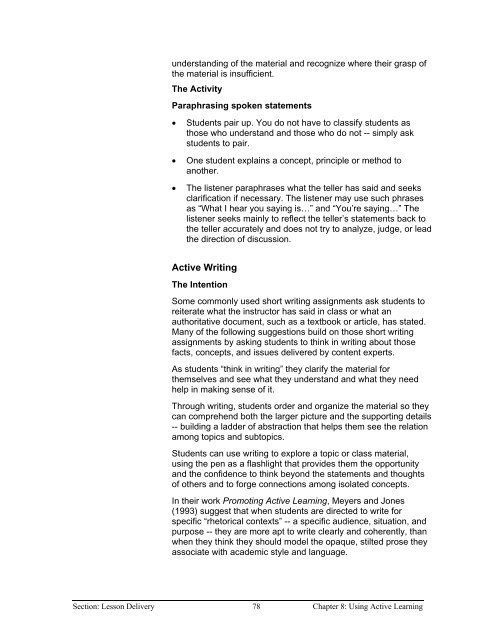Chapter 9 - Instructional Media: Chalkboards to Video - CGISS
Chapter 9 - Instructional Media: Chalkboards to Video - CGISS
Chapter 9 - Instructional Media: Chalkboards to Video - CGISS
Create successful ePaper yourself
Turn your PDF publications into a flip-book with our unique Google optimized e-Paper software.
understanding of the material and recognize where their grasp of<br />
the material is insufficient.<br />
The Activity<br />
Paraphrasing spoken statements<br />
• Students pair up. You do not have <strong>to</strong> classify students as<br />
those who understand and those who do not -- simply ask<br />
students <strong>to</strong> pair.<br />
• One student explains a concept, principle or method <strong>to</strong><br />
another.<br />
• The listener paraphrases what the teller has said and seeks<br />
clarification if necessary. The listener may use such phrases<br />
as “What I hear you saying is…” and “You’re saying…” The<br />
listener seeks mainly <strong>to</strong> reflect the teller’s statements back <strong>to</strong><br />
the teller accurately and does not try <strong>to</strong> analyze, judge, or lead<br />
the direction of discussion.<br />
Active Writing<br />
The Intention<br />
Some commonly used short writing assignments ask students <strong>to</strong><br />
reiterate what the instruc<strong>to</strong>r has said in class or what an<br />
authoritative document, such as a textbook or article, has stated.<br />
Many of the following suggestions build on those short writing<br />
assignments by asking students <strong>to</strong> think in writing about those<br />
facts, concepts, and issues delivered by content experts.<br />
As students “think in writing” they clarify the material for<br />
themselves and see what they understand and what they need<br />
help in making sense of it.<br />
Through writing, students order and organize the material so they<br />
can comprehend both the larger picture and the supporting details<br />
-- building a ladder of abstraction that helps them see the relation<br />
among <strong>to</strong>pics and sub<strong>to</strong>pics.<br />
Students can use writing <strong>to</strong> explore a <strong>to</strong>pic or class material,<br />
using the pen as a flashlight that provides them the opportunity<br />
and the confidence <strong>to</strong> think beyond the statements and thoughts<br />
of others and <strong>to</strong> forge connections among isolated concepts.<br />
In their work Promoting Active Learning, Meyers and Jones<br />
(1993) suggest that when students are directed <strong>to</strong> write for<br />
specific “rhe<strong>to</strong>rical contexts” -- a specific audience, situation, and<br />
purpose -- they are more apt <strong>to</strong> write clearly and coherently, than<br />
when they think they should model the opaque, stilted prose they<br />
associate with academic style and language.<br />
Section: Lesson Delivery 78 <strong>Chapter</strong> 8: Using Active Learning
















